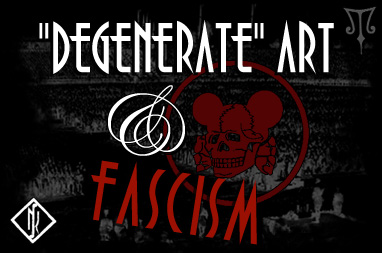Translations available in:
I will be called 'degenerate,' but I will not allow my art to be labeled as such!
Marilyn Manson, February 2003
A major theme in The Golden Age Of Grotesque was a hearkening back and drawing influences from various points in history, including the present, which were grotesque, decadent and debaucherous, as well as those which were deemed as such. One of these which is the most prominent, both in history as well as Manson's inspiration for The Golden Age Of Grotesque was the art and artists who were deemed as "degenerate" by the rising Nazi party in 1930's Germany. Though not always drawn from so explicitly, this has always been a major theme in Manson's art; the dichotomy and constant battle of expressionism and censorship. A theme which still exists in America today. Although art may not be banned today (at least not often successfully so), the suppression of progressive, new and innovative ideas in art and expressionism exists very much so. And if not by banning, by self-imposed societal standards as to what is "beautiful" and "ugly", something which can oft be just as dangerous and damning. A theme which Manson has always fought against.
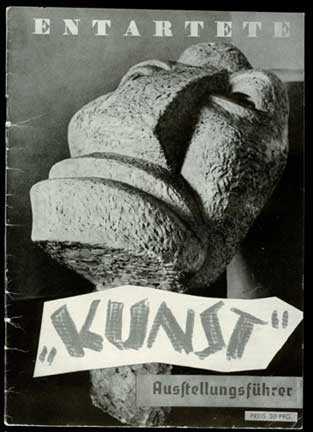 |
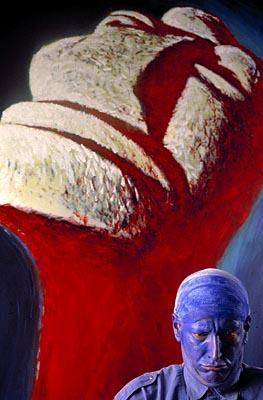 |
| Exhibition catalogue for "Entartete Kunst" exhibtion |
Gottfried Helnwein God as Baron I, 1987. |
In Europe, and specifically Germany, after World War I, the growing apathy of the youth and the increasing disillusionment towards the government after their betrayal unto them by being led into the most horrific war ever known to man up until the time, gave rise to the most progressive movements which the art world had ever seen. The youth which were filled with feelings of disillusionment and apathy, used this rage, their ennui, or boredom, to their advantage and begun such movements such as cubism, dada, surrealism and expressionism. Unlike how it's viewed and taught in schools today, art to them was something tangible, something that affected change, it was an escape, and for some a necessity in keeping sanity. Virtually the entire civilised world was in a state of disarray after World War I, and the art movements of this time reflected and expressed this global disposition. Art, with such incendiary movements such as dada, became ugly, became shocking; art was the artist's revenge against the world who had led him astray and beaten him down and its ugliness and harshness was the mirror that reflected the degradation of the society around him, it was the artist as the prolific and incendiary creation of the society he lived in.
 |
 |
| Entrance ticket to a "Degenerate" Art exhibition. |
"Degenerate" Art Museum opening. |
But not everyone is able to find their salvation in art, nor did everyone appreciate the scathing and grotesque reality which was often depicted. And though the artist was able to portray society and save himself it did not however save the plebian aggregate masses, who needed a more literal and immediate solution. The world economy had compleatly deteriorated (as this was the time of The Great Depression), currency and money had become literally another form of toilet and wall paper. When the Nazi party came to power, through terror and blackmail namely, it was promised that all said problems would be alleviated and Germany would be restored to its great and empiric state, something which was also done. Though in the process, in restoring all which was purely and patriotically German, anything deemed un- Germanic or unglorifying to the fatherland was demonized, villified and ridiculed. Most familiar and recognizeable were the book burnings of works deemed un- Germanic and the mass persecution of the Jews. But along with these came the persecution of art and expressionism.
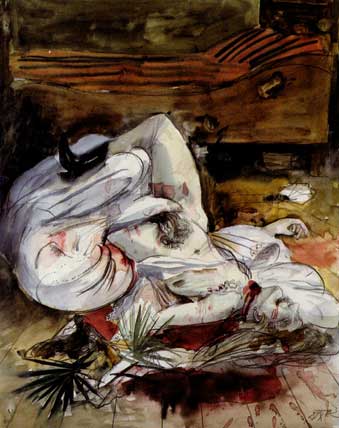 |
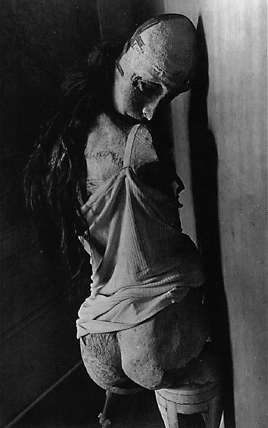 |
| Mord or Murder, watercolour by Otto Dix. |
Hans Bellmer, Doll (La Poupée), 1934. |
Shortly after coming to power and the Nazi's restoration of German patriotism came the persecution of art, entertainment and those who participated in them. Many and most of the progressive works of art were deemed "degenerate", confiscated and either sold, burned or set on display as a ridiculed spectacle in what came to be known as "degenerate Art" Museums. Works of artists such as Salvador Dalí, Pablo Picasso, Paul Klee, Max Ernst, Edvard Munch and, two of the most notable of the era and to our purposes here, Otto Dix and George Grosz. The traveling "degenerate Art" museums were some of the greatest and most progressive art exhibitions which the world has ever seen or known, yet ridiculed and demonized in place of the praise they were deserved. Paintings were often auctioned off, vandalized or hung askew in mockery.
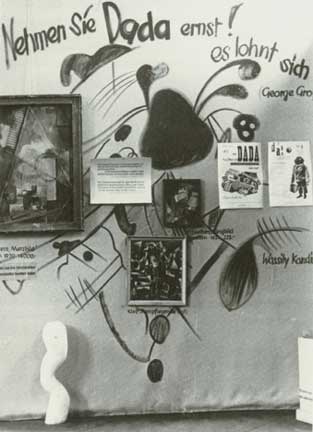 |
 |
| Detail of the Dada wall at the "Entartete" Kunst exhibition. |
Collection of Nazi confiscated "Degenerate" Art. |
This is where the term LOW ART GLOOMINATI comes into play with Manson's lyrical poetry. LOW ART as a synonym for "Degenerate" Art, which is purposefully evoked as an empowerment to expressionism; by demonizing oneself beforehand, it leaves little rest for any one possessing critical and belittling eyes to condemn. Which is also in itself a belittlement towards this belittlement of progressive art; to empower it through its evocation. And 'GLOOMINATI' as a play on the words, the prefix gloom juxtaposed with Illuminati to insinuate Marilyn Manson as a dark, overly sinister misery spreading entity, which again is done so sarcastically as they bring nothing but joy to myself and anyone else who gets "it".
....the LOW ART GLOOMINATI aimed to depress.
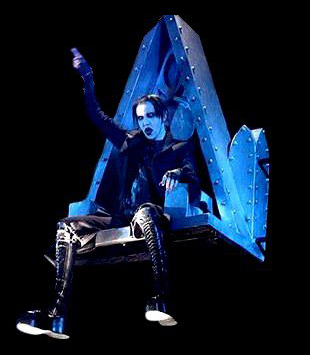 |
 |
| Manson emerging on a triangular elevated platform during his 'Thaeter' introduction to the Grotesk Burlesk tour. |
Pyramid and all-seeing eye in triangle, believed by some to be a hidden symbol of the Illuminati's supposed New World Order. |
All the art we have done, has many levels, but in regards to Mickey...his image was also considered to be 'degenerate' by the fascist government in [1930's Germany]. In America he represented so much more. These are pieces of the imagination, no more, no less.
Marilyn Manson
February 2003The photo in the middle of The Golden Age Of Grotesque album booklet is Manson is made up in Black Face. Black face was a type of theatre makeup in the early Vaudville and American theatre where, before blacks were allowed to act, a white was made up with black face paint with a white ellipse around the mouth and occasionally white circles around his eyes. The principle involved is similar to men dressed in feminine guise in the Shakespearean days when women were not allowed to partake in theatre acting. And the same in traditional Japanese theatre today.
The fact that Manson is dressed in Black Face is representative further of his art being deemed as "degenerate" by judgemental society, just as black culture was deemed as "degenerate" and forced into dimminuative servitude throughout American history, yet also embraced by white culture simultaneously. Just as today when 70% of the consumers of rap music, a phenonenom from the streets of black culture, are from young middle class whites. The dichotomy of fascination and demonization.
Also hearkening back to Manson stating that, "I will be called 'degenerate,' but I will not allow my art to be labeled as such!" This "degeneracy" is not a literal one, just as the art in the "Entartete" Kunst, "Degenerate" Art exhibitions of Nazi Germany were in context and reality anything but degenerate. They were some of the greatest and most progressive works of art ever on display but villified and belittled as "degenerate" because that's what those who were in power ingrained this fascist morality and standard of beauty unto society. Just as Manson has fought against the today self imposed "The Fascism Of Beauty" which society willingly imposes upon itself. Manson gazing into a mirror, mockingly and uncaringly of of society's fascist standards, admiring his own "degenerate" beauty.
 |
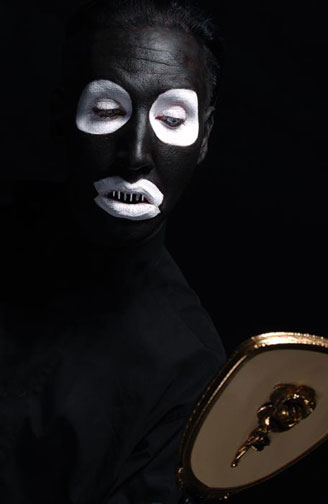 |
| Example of the old vaudeville Blackface makeup, by Al Jolson. |
Manson and Gottfried Helnwein collaborative photograph. |
Before the Civil War, and before slavery was abolished, there was a form of entertainment called minstrel shows. These minstrel shows started in 1828 and were popular from 1841-1870. The white performers would cover their faces with burnt cork. This style of make-up was called black-face make-up. The performers would then go on stage and mimic the "down on the farm" lifestyle of the slaves on the southern plantations. This was done through music, song, dance, and acting. Although this type of show today would be considered racially degrading, in the mid-1800's it was popular with the white audience of the time. After the civil war these minstrel shows lost their popularity. But some of the minstrel acts moved onto the vaudeville stage, bringing their black-face make-up with them. These performances in vaudeville led to African-Americans themselves putting on black-face make-up and creating vaudeville routines. Initially African-American performers put on black-face so that they would be accepted by the audience, since the mostly white audience had never seen African-American entertainers.
LazerVaudeville.com Collaboration between Helnwein and Manson to promote the album.
Collaboration between Helnwein and Manson to promote the album.I was not allowed to put the paintings on the cover of the record! Our anticipation was not to create album artwork. We wanted to create a collaboration, and from that came the idea to use it for the cover, because we did not consider the Golden Age of Grotesque to be limited to an album. An album is very limited with censorship, and with time constraints and space constraints. We did intend for the white and black images of me with the ears to be the front and back.
I feel the black one is very American, and the white one is very European. The black one is somewhat more evil, and the white one is kind of innocent. I actually think that the white one, visually, strikes me as more evil. It's like a Pierrot. You know, American versus European. The entire time that I did it, I don't think anyone mentioned the blackface and the relevance of it. The relevance of it is the exploitation of a performer, or an artist. The Mickey Mouse was invocative because of the hat, and a lot of people feared that it would be a lawsuit from Disney, but it does not even, in it's fullest frame, show both ears. The hat that I ended up making is very similar, but it's asymmetrical, because I have a real problem with symmetry. I like things to be different on both sides, like my brain. The white one, on the other side, is like the child.
All I can say about it is I'm glad that it makes it into the collection of images that represent me as best as it could. I think that it just scratches the surface of what Gottfried and I could do together. Also I think it was most appreciated and understood for it's biggest quality and it's biggest political impact.
Like I said, people can take it anyway they want. People took it as serious as it could be in Europe, particularly in France and Paris, and in Japan because they saw my commentary on America. They saw me as much as people see Mickey Mouse as an American symbol. You cover your mouth with blackface, which really represents a franchise, moneymaking, and slave creation of entertainment, that isn't even human. That's an animal, on top of a podium that is exaggerated - a comedy form of fascism. It sounds very American to me. It sounds like a Happy Meal. That's not to say that's the only way you need to look at it.
Interview with Marilyn Manson for INROCK
By Evie Sullivan, July 2004
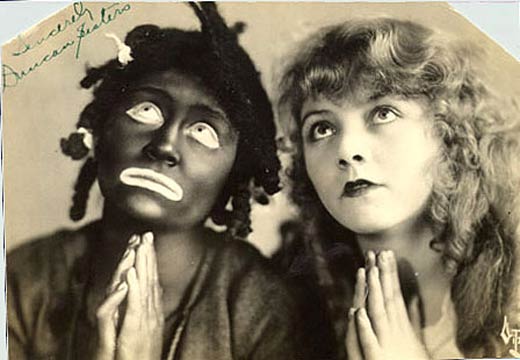 |
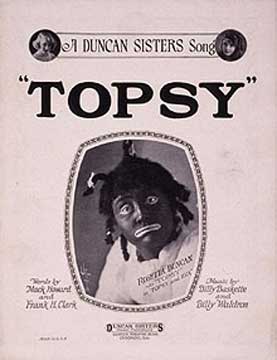 |
| Topsy & Eva, a vaudevillian musical-comedy play by the Duncan Sisters, a retelling of Uncle Tom's Cabin
with the central focus on the novel's inversed pair of children, Topsy and Eva, instead of Uncle Tom. |
Very few, if any, of the thousands who brought Uncle Tom's Cabin to the stage did so to promote Stowe's message. When the Duncans discovered the possibilities of using the novel to expand their own career, surely they had neither the proper role for Christians nor the horrors of slavery in mind. The stories they told about how they became Topsy and Eva are all tempered by the fact that they appeared in response to press interviews. The most broadly distributed version appeared in The American Magazine in August, 1925. The sisters were established vaudeville stars by that time. 'A little more than two years ago,' Rosetta told an interviewer, 'a man came to us to see about doing something in motion pictures.' After several ideas were broached and dismissed, 'finally he said . . . "I guess we'll have to black you up."'
UTC & Slavery
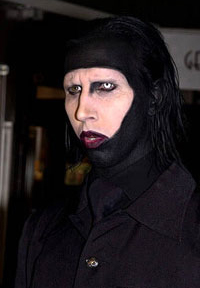 |
 |
| Partly blackfaced Manson on the red carpet of the Winter 2002 premiere of Resident Evil, revealing some of the directions of his upcoming Golden Age of Grotesque era. Note Skold's Günter Brus-inspired self-painting.
|
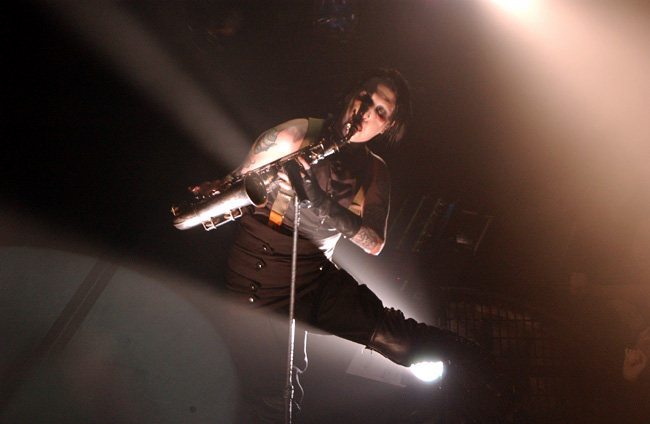 Manson playing the saxophone for the Grotesk Burlesk
evocative of the "Nigger-Kike," "Degenerate" Musik of the 1930's.
Manson playing the saxophone for the Grotesk Burlesk
evocative of the "Nigger-Kike," "Degenerate" Musik of the 1930's.
Photo by Cyril Helnwein.Along with works of art and literature that were banned, confiscated or burned, the Nazi intrusion in German life also extended to music and entertainment. Both swing and jazz were banned, demonized as "degenerate", labeled as "Nigger-Kike" music. Nightclubs and record stores were raided to smash the perpetuation of them and the dissuade interest through fear and terror. Similarly, forms of theatre such as Cabaret and Vaudeville were also deemed as such, with night clubs and theatres who housed such performances either raided or shut down. The term "Swing Heil" Manson sung in Doll-Dagga Buzz-Buzz Ziggety-Zag was a mantra coined during this time period, as a mockery toward the Nazi "Sieg Heil" which sought to smash and efface them. Two films which portray this quite well are Swing Kids and Cabaret, more of which can be read about in The CELLULOID section.
 |
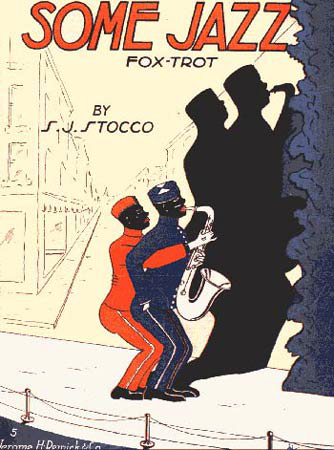 |
| Exhibition catalogue for "Entartete Musik" exhibtion. The "Nigger-Kike" Star of David is seen pinned upon the black Jazz performer. Propaganda which coincided directly with the "Entartete Kunst" villification in mid to late 1930's Germany by the Nazi Party. |
"Some Jazz 1919, Music by S.J Stucco.A very interesting cover for this instrumental Fox Trot. It appears to be a two person vaudeville act with the African American performers in black face. This was not unusual. At the time, there were very few Black performers on the White vaudeville (Keith) circuit, most were required to perform in black face." ....Jass.com |
Again, a the theme of the war between expressionism and censorship which has always been integral to Manson's art. And much of the imagery Manson portrayed within The Golden Age Of Grotesque is evocative of this very time period. With these particular examples Manson identifying with the persecuted, which Manson is no stranger to from religion and entertainment. Along with Blackface, Manson playing the saxophone on The Golden Age Of Grotesque and live in the Grotesk Burlesk is another facet which is evocative of those forms of entertainment which were deemed "degenerate". The saxophone being an instrument synonymous with Jazz music makes this a befitting reference.
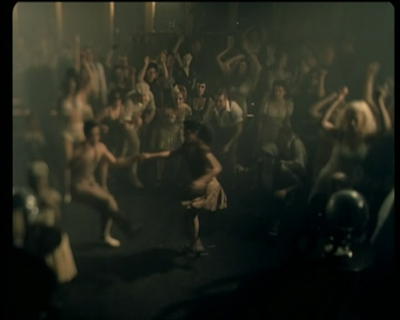 |
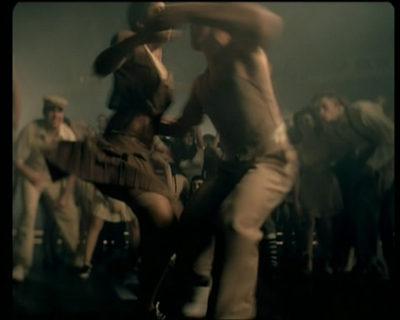 |
| Swing scene from the mOBSCENE video (actually shot with the song 'Doll-dagga-buzz-buzz-ziggety-zag' playing and inspiring the dancers).
|
"Hellzapoppin, open your Third Nostril,
Put on your black face and your god is gone."
Marilyn Manson, The Golden Age Of Grotesque
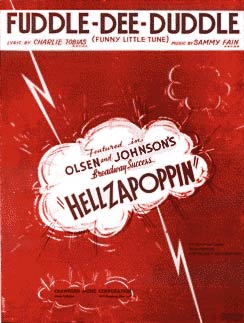 |
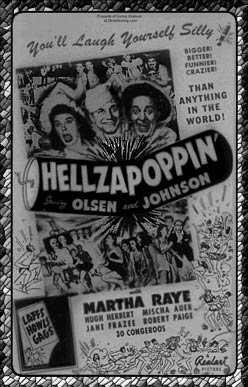 |
| Hellzapoppin Broadway performance program and poster for the inspired 1941 film based on the Swing phenomenon of the period. Manson referenced the film in The Golden Age Of Grotesque title track as well as the Swing scene in the mOBSCENE video. |
Along with elements of musik, art & performance which were deemed "degenerate" by the Nazi Party, conversely Manson's art and The Golden Age Of Grotesque is full of elements evocative of Nazism portrayed and used in a "degenerate" manner thus bringing together the dichotomy of "good" & "evil", expressionism & fascism, black & white, Marilyn & Manson.
 Still frame of Marlene Dietrich in the film Blue Angel and UFA, Universum Film Aktien Gesellschaft, (Universal Film Company), logo, as seen watermarked on lower left of still frame. Above, Nazi iron eagle swastika insignia. Manson's diamond shaped Golden Age Of Grotesque logo combined this dichotomy of repression and expression, as well to illustrate the fascism of entertainment.
Still frame of Marlene Dietrich in the film Blue Angel and UFA, Universum Film Aktien Gesellschaft, (Universal Film Company), logo, as seen watermarked on lower left of still frame. Above, Nazi iron eagle swastika insignia. Manson's diamond shaped Golden Age Of Grotesque logo combined this dichotomy of repression and expression, as well to illustrate the fascism of entertainment."We're a death-marching band"
Ka-boom Ka-boom
The Golden Age Of Grotesque
 |
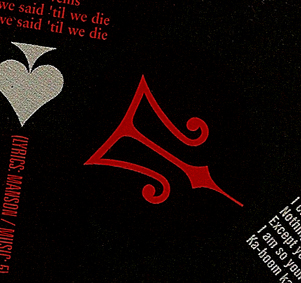 |
| Though worn by many military band troupes throughout the world, the insignia on Manson's jacket is one which was also worn by Nazi military bandsmen. A stylized version of it appears in The Golden Age Of Grotesque booklet next to the song Ka-Boom Ka-Boom which opens with the line quoted above. |
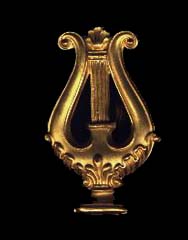 |
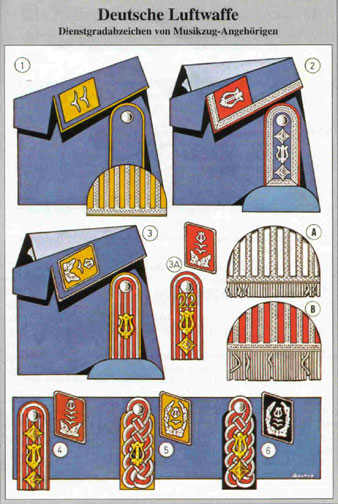 |
| Another example as a Belgian Infantry (1893-1914) musician collar badge (Link) and diagram of a Luftwaffe Nazi military musician's regalia. The Schwalbennester shoulder decoration as well as the lyre shaped musician collar badge can both be seen. |
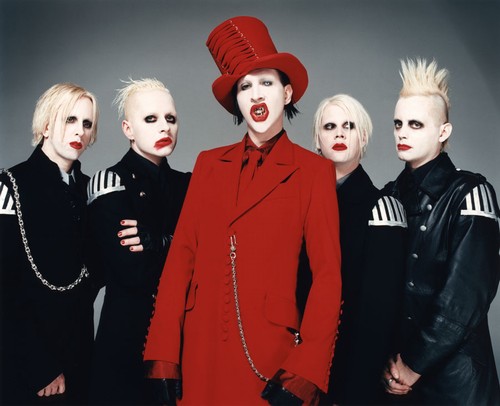 |
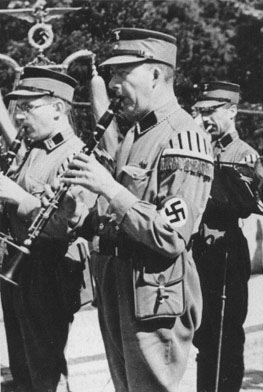 |
| Marilyn Manson dressed as a 1940's big band conductor & the band dichotomously dressed as nazi military bandsmen during
The Golden Age Of Grotesque, wearing Schwalbennesters, or Swallows Nests, on their shoulders. Right : Nazi military bandsmen who are signified as such by their Schwalbennesters. |
 SS Death's Head military marching band.
SS Death's Head military marching band.
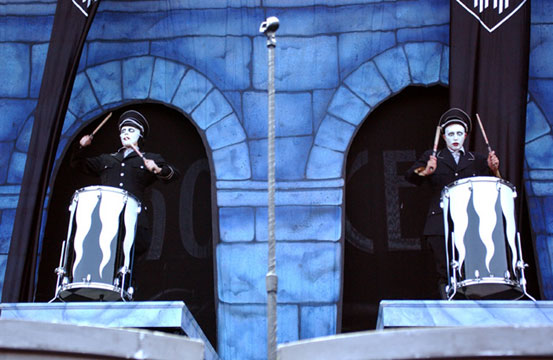 |
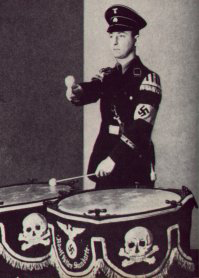 |
Nuremberg Rally-esque stage set for the Grotesk Burlesk with the two women back-up dancers in
Manson masks, SS attire complete with Nazi HJ (Hitler Jugend) drums. Photo by Cyril Helnwein. | |
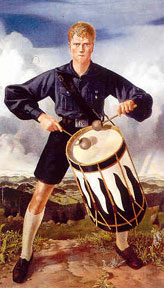 |
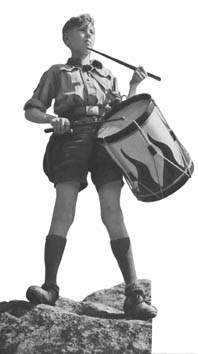 |
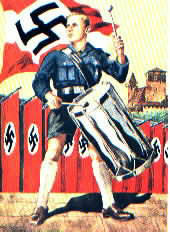 |
| Young Aryan drummer boy in the Hitler Youth & two poster print depictions. |
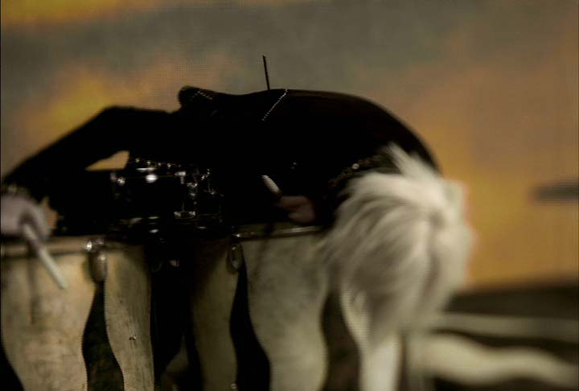 |
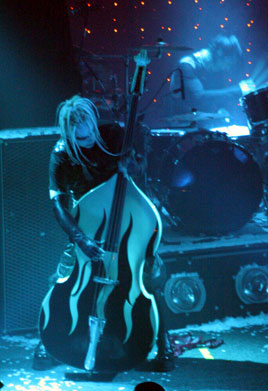 |
| Left : Ginger Fish in the video for Personal Jesus with Hitler Youth drums. Right : Skold on the Against All Gods tour playing the stand-up jazz bass on The Golden Age Of Grotesque, juxtaposing the imagery of "Entartete/Degenerate" Musik with decor of the repressive & fascist Nazi musicians who condemned it. Photo by Cyril Helnwein. |
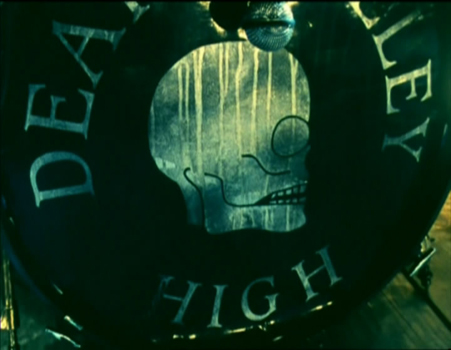 |
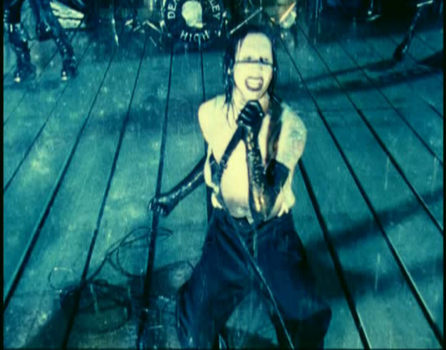 |
| Reappropriated Death's Head printed on bass drum, standing for the 'Death Valley' team in the Fight Song video.
|
"Fight, fight, fight, fight"
Marilyn Manson, The Fight Song
Holy Wood
 |
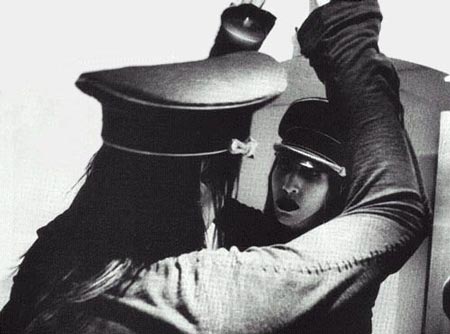 |
| Manson donning his SS-inspired visor cap in the Fight Song video and on a Holy Wood era promo shot. |
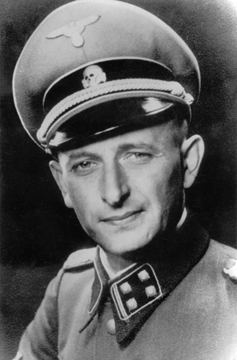 |
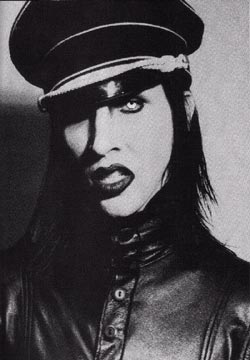 |
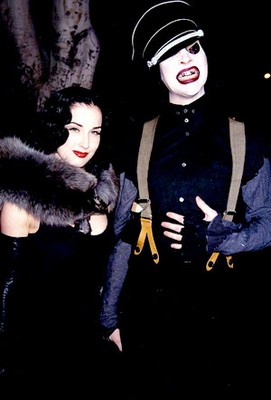 |
| Adolf Eichmann head of the Gestapo department for Jewish affairs
& Manson with SS visor cap, minus the Nazi regalia. |
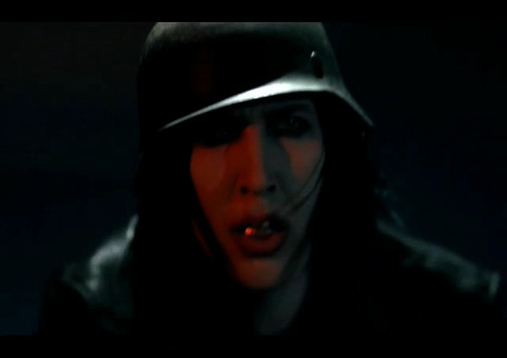 |
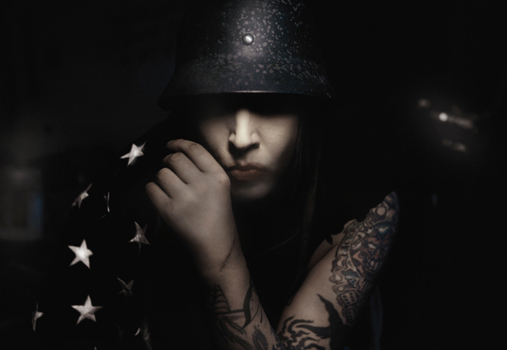 |
|
Manson donning the SS infantry hat in the video for Arma-goddamn-mother-fuckin-geddon, and a promo picture of him wearing the same helmet and draping himself with the star-spangled banner.
|
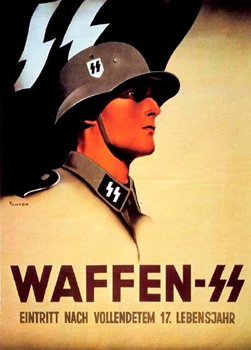 |
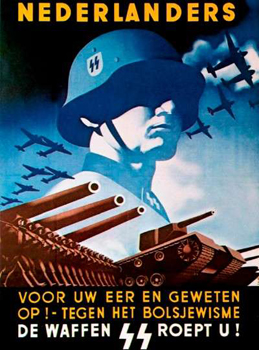 |
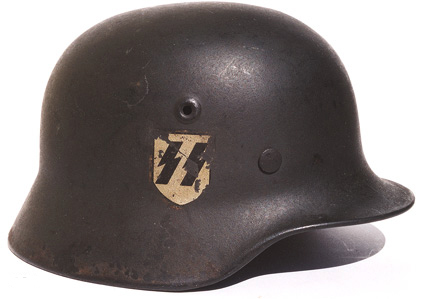 |
| Propaganda posters of the Waffen-SS and an example of the SS helmet. |
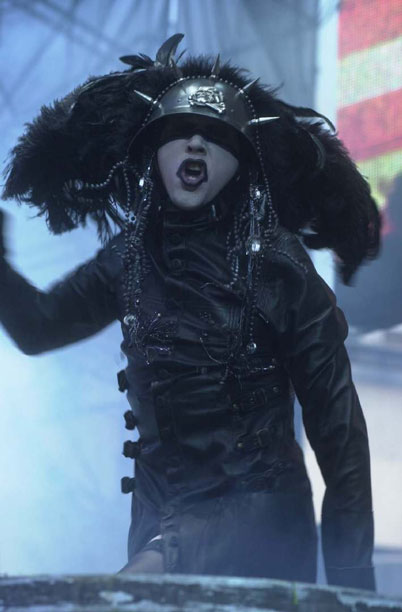 |
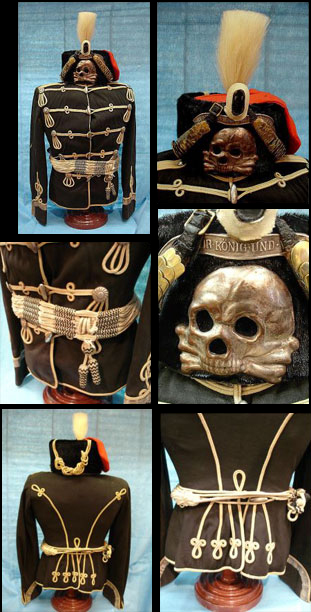 |
| Prussian Death's Head Hussar uniform & Manson in full performance regalia during the
Summer 2001 Ozzfest portion of the Guns, God & Government World Tour. Also a modern evocation of anti-Christian tyrant and alleged biblical beast of Revelation Nero Caesar. |
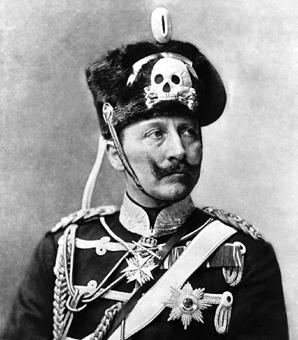 |
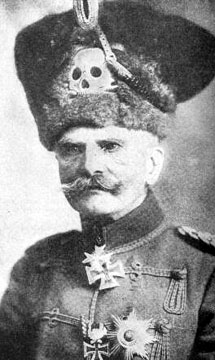 |
| German Kaiser Wilhelm II and August Von Mackensen, respectively, wearing a Hussar Death's Head busby. The Hussar, who originated in 15th century Hungary, is a term which applies to the ornately uniformed members of European light cavalry. The Death's Head Hussars originated in Prussia, now modern day Germany, and can be looked at as something of an early precursor in the German military to the Nazi Schutzstaffel (or SS) Death's Head squadron. August Von Mackensen joined the elite Death's Head (or Totenkopf) Hussar at the age of 19, fighting "with distinction" in the Franco-Prussian War (1870-71) subsequently becoming something of a German military hero in the First World War. Though retired he joined the Nazi party 1933. (Link) |
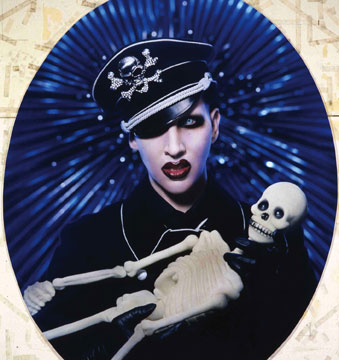 |
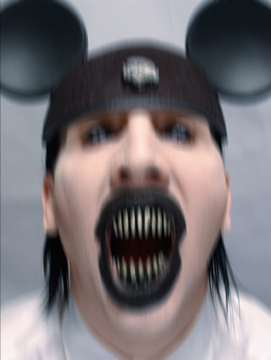 |
| Manson with SS cap ornated with a grotesque Skull and Bones ornament replacing the traditional Nazi totenkopf, on the Pierre & Gilles 2004 photograph "The Dead Song" to be found in the Lest We Forget album artwork (and DVD menu), credited as "Officer portrait".
|
Photograph of Manson with metal teeth, mouse-eared cap and identifiable SS Death's Head badge from his Golden Age of Grotesque collaboration with Helnwein, and first unveiled as an easter egg by solving a coded sequence of the 2006 Flash Celebritarian Emblem incarnation of MarilynManson.com, and shortly before in the Phantasmagoric introduction of the site. |
 Totenkopf/Death's Head badges usually attached on SS headgear (or embroided on insignias), adopted by the Nazis from their historical tradition to use it for their own purposes, leaving it marked with a stigma that has continued to the present day.
Totenkopf/Death's Head badges usually attached on SS headgear (or embroided on insignias), adopted by the Nazis from their historical tradition to use it for their own purposes, leaving it marked with a stigma that has continued to the present day.
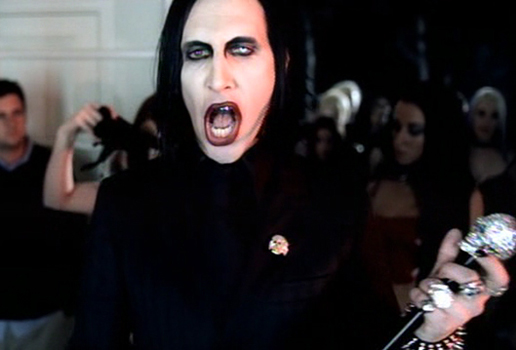 |
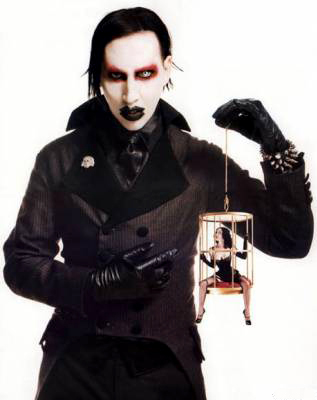 |
| Manson sporting a similar Totenkopf badge in the Tainted Love video and a later promo shot during the Golden Age of Grotesque.
|
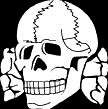 |
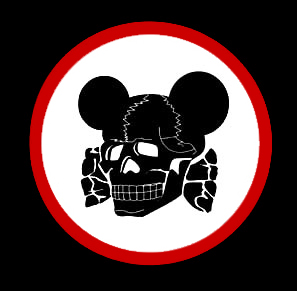 |
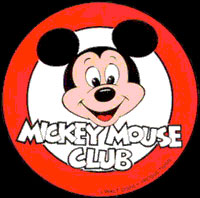 |
| Death's Head insignia worn by the elite Nazi Schutzstaffel (SS) & Disney's Mickey Mouse Club logo. |
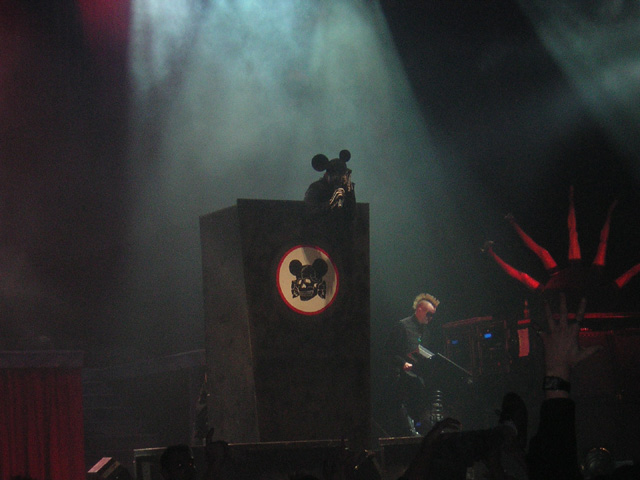 |
| "I'm not a slave"; performance of The Fight Song with Manson made up in black face wearing Manson Mouse ears above a rodent Death's Head emblem on the Grotesk Burlesk. Manson's own version of the Nuremberg rallies which brings together the dichotomy of the polar opposites of expressionism and fascism. |
Like I said, people can take it anyway they want. People took it as serious as it could be in Europe, particularly in France and Paris, and in Japan because they saw my commentary on America. They saw me as much as people see Mickey Mouse as an American symbol. You cover your mouth with blackface, which really represents a franchise, moneymaking, and slave creation of entertainment, that isn't even human. That's an animal, on top of a podium that is exaggerated - a comedy form of fascism. It sounds very American to me. It sounds like a Happy Meal. That's not to say that's the only way you need to look at it.
Interview with Marilyn Manson for INROCK
By Evie Sullivan, July 2004
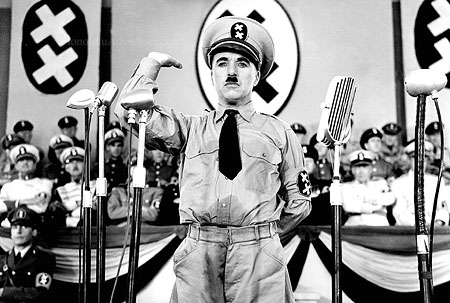 |
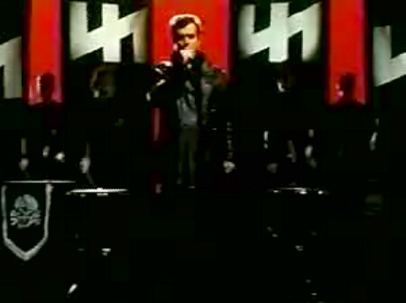 |
| Chaplin in "The Great Dictator", with double-crossed banners and insignias of the fictitious country of Tomania, parodying Hitler's Swastika. |
Boyd Rice's performance of "Total War", with Death's Head drummers and Wolfsangle banners, another nazi symbol that would partly inspire Manson's eagle-shaped Ms. |
Thematically, Manson's mock portrayal of fascism and Nazi imagery is reminiscent of Charlie Chaplin's highly controverisal 1940 film, The Great Dictator, in which he ridicules Hitler & the Nazi party by satire, using comedy as a means to warn the world of the very real dangers of the impending fascism of the late 30's. And Manson has done so in a very similar sense in regard to the parallels of repression today, both by religion & government but also to decry the imposition of self-censorship which is forced and ingrained into society today. The ensued ambiguity is also quite reminiscent of Boyd Rice's performances, an important influence for Manson from whom he also borrowed his Celebritarian Double-Cross.
"The time has come to... REPENT!"
Marilyn Manson, Antichrist Superstar
Antichrist Svperstar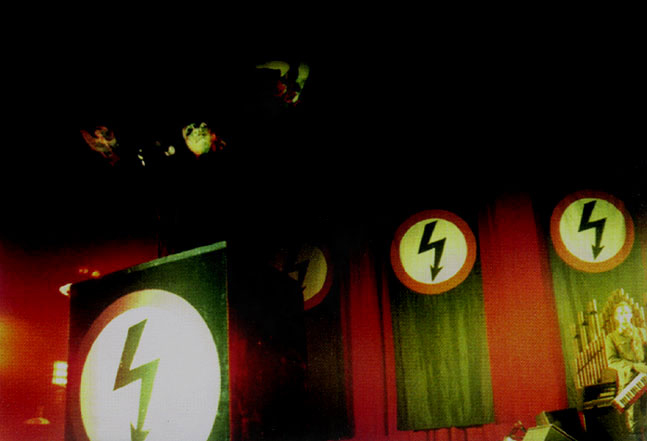 Live Performance of Antichrist Svperstar which echoes of the Nazi Nuremberg rallies of the 1930's, with Manson tearing pages from the Bible portraying religious evangelists as fascists from his Shock podium.
Live Performance of Antichrist Svperstar which echoes of the Nazi Nuremberg rallies of the 1930's, with Manson tearing pages from the Bible portraying religious evangelists as fascists from his Shock podium.
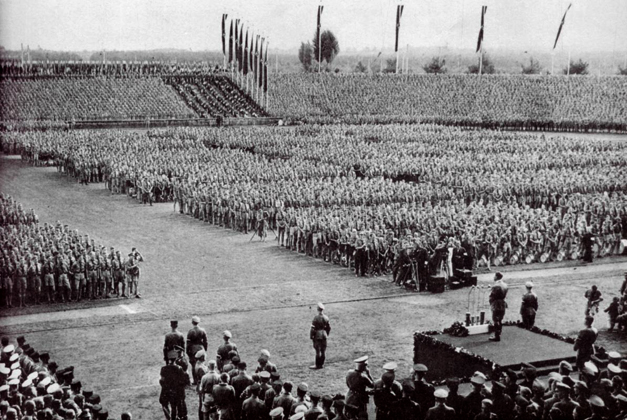 |
 |
| Left; Adolf Hitler addresses Hitlerjugend (Hitler Youth) at a Nuremberg Nazi Party Day rally. Right; Nazi blitz military pins, the motif of which partly inspired Manson's Shock logo.
|
"Do you love your guns? god? your government?"
Marilyn Manson, The Love Song
Holy Wood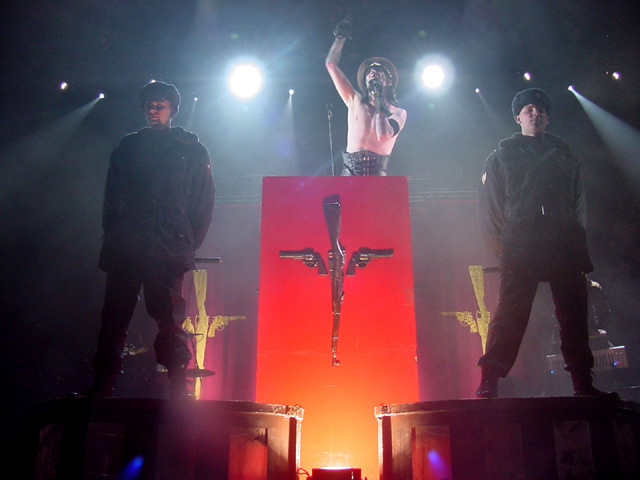 The Love Song; Manson on the Guns, God & Government tour in Moscow, leader of another Nuremberg-esque rally
for our society today where violence is religion and where fame & death on camera is better than life itself, as symbolized by the Gun Crucifix.
The Love Song; Manson on the Guns, God & Government tour in Moscow, leader of another Nuremberg-esque rally
for our society today where violence is religion and where fame & death on camera is better than life itself, as symbolized by the Gun Crucifix.
"Capitalism has made it this way, old-fashioned fascism will take it away."
Marilyn Manson, The Beautiful People
Antichrist Svperstar
 |
 |
| Print Mafia posters for two 2008 U.S. venues of Marilyn Manson's Rape of The World tour, evoking Manson's capitalism/fascism dichotomy in 'The Beautiful People', and foreseeing the interchangeability of the swastika and dollar sign during the High End Of Low era.
|
"When I see you in the sun you're as pretty as a swastika."
Marilyn Manson, Pretty as a $
The High End Of Low
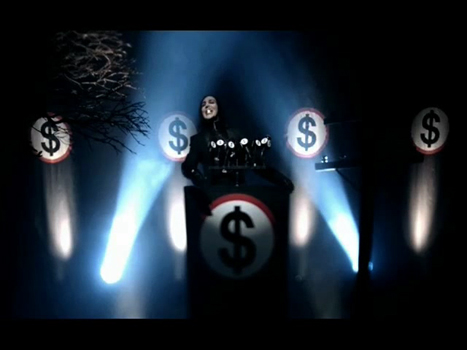 |
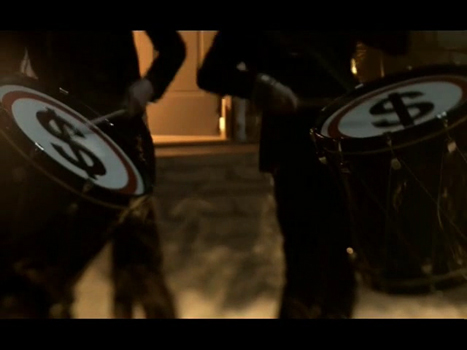 |
Still frames from the Arma-goddamn-mother-fuckin-geddon video, with podium, banners, microphones and drums all emblazoned with a $ symbol circled in red, serving as a substitute swastika. A sarcastic statement of money being the ultimate form of fascism today, dictating consensuality and censorship of artists, showing through even more with the track 'Pretty as a swastika' being retitled 'Pretty as a ($)' to avoid its deletion. |
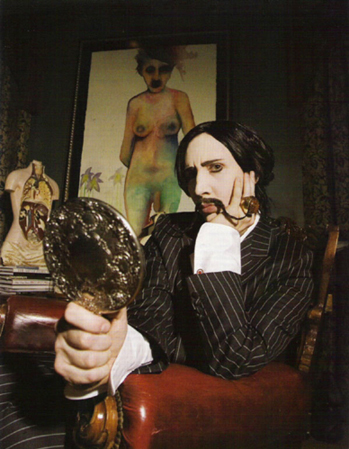 |
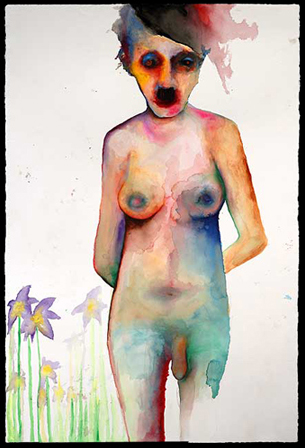 |
| Manson as Dalí on a 2006 shot for Juxtapoz magazine, with his 1999 watercolor painting 'Die Deutsche Kampferin' (The German female fighter, a title derived from a woman's magazine Nazi propaganda) representing an androgynous Hitler, a reference to Dalí's fascination for fascism, particularly the sensuality and eroticism he claimed to see in Hitler, and to the "degenerate" nature of his work. Also notice the columbines next to the chaplinesque figure. |
"This one was very much a dedication to Dalí because he had painted 'Hitler as a Housewife' and the paintings were destroyed when he exhibited them with the exhibition for Un Chien Andalou with Bunuel, and so no one has ever seen them. So when I was reading about them, I wanted to paint something in return, but living in Hollywood I thought there was a bit of Chaplin in it all. I think it's funny when you have a mustache and it really defines sort of 'evil' or 'funny'. Change hats, same moustache."
Marilyn Manson, at the vernissage of his Trismegistus art show
December 5, 2008Other watercolors by Manson emerged since then with references to Hitler and the swastika :
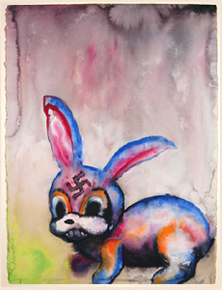 |
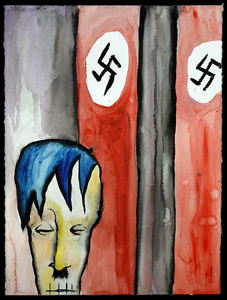 |
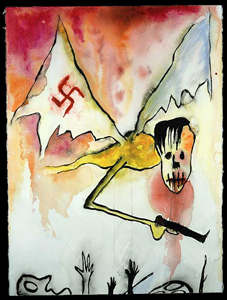 |
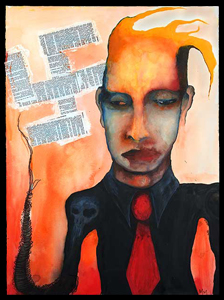 |
| Bunny (ca. 2000) |
Hitler takes a nap (2004) |
Vampyr (2004) |
Portrait of Tim (2006) |
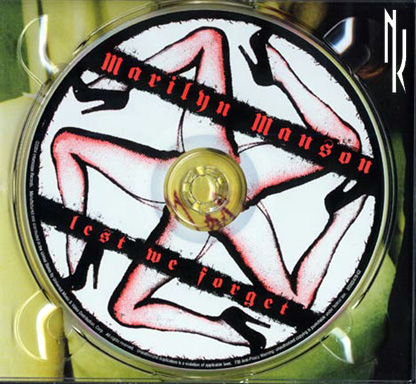 |
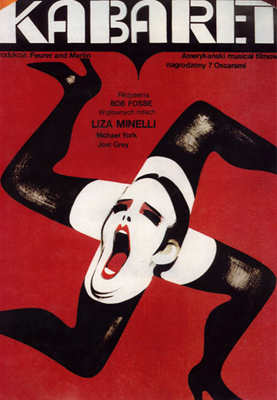 |
| Poster for the 1972 film Kabaret, and Manson's strongly reminiscent legs pentagram/swastika printed on the Lest We Forget CD and DVD, in continuation with the Grotesk Burlesk aesthetics, props and principles. A perfect illustration of the expression 'Pretty as a Swastika'.
|
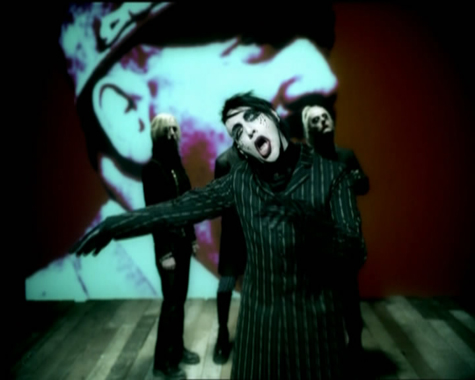 |
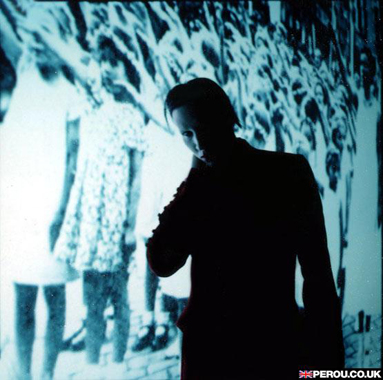 |
| Manson mimicking 'The Day the Clown Cried' with a projection of Hitler in the background in the video for Personal Jesus (the same image also appears subliminally in the video, alternated with pictures of George W. Bush and Christ). |
Manson photographied by Perou in front of Gottfried Helnwein's artistic enlargement of a heiling crowd of Nazi Germany kids, disturbingly assimilated to Manson's own audience and serving the dichotomy [Swing/Goth Kids] / [Hitler/Mickey Mouse Youth] present in the Golden Age Of Grotesque. |

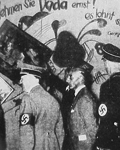
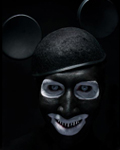
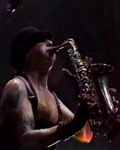
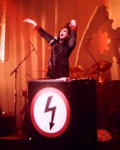
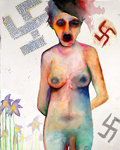











 'Sol Niger', Gottfried Helnwein on a 1987 photograph.
'Sol Niger', Gottfried Helnwein on a 1987 photograph.


 Collaboration between Helnwein and Manson to promote the album.
Collaboration between Helnwein and Manson to promote the album.



 Manson playing the saxophone for the Grotesk Burlesk
evocative of the "Nigger-Kike," "Degenerate" Musik of the 1930's.
Manson playing the saxophone for the Grotesk Burlesk
evocative of the "Nigger-Kike," "Degenerate" Musik of the 1930's.







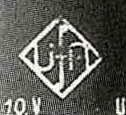
 Still frame of Marlene Dietrich in the film Blue Angel and UFA, Universum Film Aktien Gesellschaft, (Universal Film Company), logo, as seen watermarked on lower left of still frame. Above, Nazi iron eagle swastika insignia. Manson's diamond shaped Golden Age Of Grotesque logo combined this dichotomy of repression and expression, as well to illustrate the fascism of entertainment.
Still frame of Marlene Dietrich in the film Blue Angel and UFA, Universum Film Aktien Gesellschaft, (Universal Film Company), logo, as seen watermarked on lower left of still frame. Above, Nazi iron eagle swastika insignia. Manson's diamond shaped Golden Age Of Grotesque logo combined this dichotomy of repression and expression, as well to illustrate the fascism of entertainment.





 SS Death's Head military marching band.
SS Death's Head military marching band.
























 Totenkopf/Death's Head badges usually attached on SS headgear (or embroided on insignias), adopted by the Nazis from their historical tradition to use it for their own purposes, leaving it marked with a stigma that has continued to the present day.
Totenkopf/Death's Head badges usually attached on SS headgear (or embroided on insignias), adopted by the Nazis from their historical tradition to use it for their own purposes, leaving it marked with a stigma that has continued to the present day.








 Live Performance of Antichrist Svperstar which echoes of the Nazi Nuremberg rallies of the 1930's, with Manson tearing pages from the Bible portraying religious evangelists as fascists from his Shock podium.
Live Performance of Antichrist Svperstar which echoes of the Nazi Nuremberg rallies of the 1930's, with Manson tearing pages from the Bible portraying religious evangelists as fascists from his Shock podium.


 The Love Song; Manson on the Guns, God & Government tour in Moscow, leader of another Nuremberg-esque rally
for our society today where violence is religion and where fame & death on camera is better than life itself, as symbolized by the Gun Crucifix.
The Love Song; Manson on the Guns, God & Government tour in Moscow, leader of another Nuremberg-esque rally
for our society today where violence is religion and where fame & death on camera is better than life itself, as symbolized by the Gun Crucifix.














